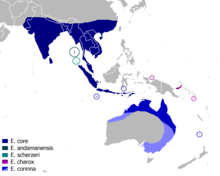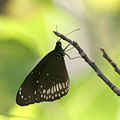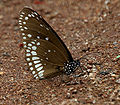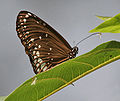- Euploea core
-
"Common Crow" redirects here. For the bird, see Corvus (genus).
Common Crow Common Crow feeding on Lantana flowers. Kerala, India Scientific classification Kingdom: Animalia Phylum: Arthropoda Class: Insecta Order: Lepidoptera Family: Nymphalidae Genus: Euploea Species: E. core Binomial name Euploea core
(Cramer, 1780
The Common Crow (Euploea core) is a common butterfly found in South Asia. In India it is also sometimes referred to as the Common Indian Crow, and in Australia as the Australian Crow. It belongs to the Crows and Tigers subfamily of the Nymphalidae (Brushfooted butterflies).
The Common Crow is the most common representative of its genus Euploea. Like the Tigers (genus Danaus), the Crows are inedible and thus mimicked by other Indian butterflies (see Batesian mimicry). In addition, the Indian species of the Euploea genus shows another kind of mimicry, Müllerian mimicry. Accordingly, this species has been studied in greater detail than other members of its genus in India.
Contents
Description
The Common Crow (Euploea core) is a glossy black butterfly with brown underside with white marks along the outer margins of the wing. The wingspan is about 8-9 cm and the body also has prominent white spots.
Upperside dark brown, broadly paler along terminal margins; Fore and hind wing with subterminal and terminal series of white spots; on fore wing the former more or less oval, curved inwards opposite apex, the latter series often incomplete, not reaching apex, the spots smaller; often there is a small costal spot, and very rarely a spot in apex of cell and one or more discal spots; on the hind wing the inner series of spots are elongate, the outer conical. Underside similar, but ground-colour more uniform; cell, costal and discal spots on both fore and hind wing nearly always present.[1]
Race godarti (=E. godarti) (Northeast India and Myanmar)
Fore wing subtriangular, tornus more rounded than in E. core. Hindwing broadly ovate. Upperside dark brown, broadly paler along the terminal margins, especially on the fore wing. Fore wing with more or less incomplete and obsolescent series of subterminal and terminal small white spots, and a powdering of violaceous-white scales at apex, varying very considerably in extent from a mere trace of violaceous between the veins to a large and very conspicuous patch occupying the whole of the apex. Hind wing with a subterminal series of oval or inwardly conical and terminal series of more rounded white spots. Underside paler brown, the white spots larger, more clearly defined. Fore wing not violaceous at apex, a spot (sometimes absent) in apex of cell, and two or three discal spots. Hindwing: a spot in apex of cell, also sometimes absent, and a discal series of five small spots beyond. Antennae, head, thorax and abdomen very dark brown, and, the antennae excepted, sparsely spotted with white.[1]
Range
It is found in Sri Lanka, India, Myanmar and Australia.
Status
Very Common.
Taxonomy
The Common Crow has three races:
- Race vermiculata : (India) UPF spots increase in size towards the apex.
- Race core : (North India) These spots are more or less equal or reduce in size.
- Race asela : (Sri Lanka) These spots are very small and the terminal spots vanish to the apex.
Habitat
It is found everywhere in India right up into the mountains till 8000 feet. Occasionally it swarms in the low, wet, jungles of South India due to the abundance of its foodplants which are spread over three orders of plants.
Habits
 on damaged parts of Indian Turnsole Heliotropium indicum in Hyderabad, India.
on damaged parts of Indian Turnsole Heliotropium indicum in Hyderabad, India.
The butterfly, being protected by its inedibility, has a leisurely flight. It is often seen flying about shrubs and bushes in search of its host plants. It visits a large variety of flowering plant species.
On hot days large numbers of these butterflies can be seen mud-puddling on wet sand. This butterfly also gathers on damaged parts of plants such as Crotalaria, Heliotropium to forage for chemicals precursors to produce pheromones.
Along with other Danaids such as the Tigers, the Common Crow is one of the most common migrating butterfly species.[2][3] Males and females in equal proportions have been seen to migrate.[4]
Protection
The Common Crow is distasteful due to chemicals extracted from the latex of the food plants consumed in their caterpillar stage. Thus protected, they fly in a leisurely manner, gliding skillfully with wings held slightly above the horizontal. This indicates its protection due to inedibility to a predator. The inexperienced predator will try attacking it, but will learn soon enough to avoid this butterfly as the alkaloids in its body cause vomiting.
The butterfly has tough, leathery wings. When attacked it shams death and oozes liquid which causes any predators to release them. The butterfly thus has the ability to recover 'miraculously' after the predator thinks it has been killed.
Mimicry
The protection mechanisms of the Common Crow, as of the other Danaids, and indeed of all unpalatable butterflies, result in predators learning this memorable aspect at first hand. Predators soon learn to associate the patterns and habits of the butterfly species with unpalatability and to avoid ingesting them in future.
This advantage of protection has led to a number of edible butterfly species, referred to as the mimic, evolving to resemble the inedible butterfly, which is referred to as the model. The resemblance is not only in butterfly markings, but also in behavioural and flight patterns. This form of mimicry where an edible species mimics an inedible species is called as Batesian mimicry.
The mimics can resemble the models very closely. In some cases, it requires hand examination and reference to field guides to tell them apart. The Common Crow is a good example, being mimicked by the following butterflies:
- Common Mime, Papilio clytia form dissimilis, both male and female.
- Malabar Raven, Papilio dravidarum, both male and female.
- Common Raven, Papilio castor, female.
- Great Eggfly, Hypolimnas bolina, female.
- Ceylon Palmfly, Elymnias singala male and female. (Not in India).
The genus Euploea also exhibits Müllerian mimicry. In this form of mimicry, the members of an inedible group of butterflies find it to their advantage to resemble one another so that their recognition by possible enemies is much easier. Besides this genus, the Blue Tigers (of the genus Danaus) also exhibit this form of mimicry in India.
Life cycle
Eggs
Eggs are laid on the underside of young leaves of the host plants. The egg is shiny white, tall and pointed, with ribbed sides. Just before hatching the eggs turn greyish with a black top.
Caterpillar
Throughout its life the caterpillar stays on the underside of the leaves. The caterpillar is cylindrical, vividly coloured and smooth. It has alternate white and dark brown or black transverse bands. Just above the legs and prolegs, along the entire body is a wide orangish-red band and the head is striped black and white. The caterpillar bears four tentacle-like appendages, three towards the front and one at the back. All of them are curved backward at the tips.
 cat on the underside of a leaf in Hyderabad, India.
cat on the underside of a leaf in Hyderabad, India.
Since the host plants contain poisonous latex, the caterillar has evolved peculiar eating habits. It first chews the midrib of the leaf, cutting of its supply of latex and then goes on to nip a few of the secondary veins of the leaf, further blocking the flow of latex. Subsequently the caterpillar feeds on the leaf but only where the leaf's natural defences have been turned off. The caterpillar is able to tolerate the plant toxins and stores it in its fatty tissue and helps make the adult distasteful to predators.
The caterpillar is uniformly cylindrical. Its body is covered with bands of black and white interspersed with thick, yellow, dorsolateral spots. The most striking characteristics are the 3 pairs of long and black tentacles. The first pair is moveable and also the longest. The tentacles are present on the 3rd, 6th and 12th segments. The head is shiny, smooth and has alternating black and white semicircular bands. The legs and prolegs are black and the prolegs have white bands at their bases.
Pupa
The pupa of this species is shiny golden in color. The wing margins are marked with broad colorless bands. The abdomen has a row of black spots on each segment. The cremaster is black. The pupa later turns black.
Larval food plants
The Common Crow feeds on a large number of plants of the families Apocynaceae (Dogbanes and Oleanders), Asclepiadaceae (Milkweeds), Moraceae (Figs), Rubiaceae, Ulmaceae (Nettles) and the specific species are Aphananthe cuspidata, Asclepias curassavica, Asclepias guadeloupe, Asclepias syriaca, Calotropis gigantea, Carissa ovata, Cerbera manghas, Cryptolepis pauciflora, Cryptolepis sinensis, Cryptostegia madagascariensis, Cynanchum carnosum, Ficus benghalensis, Ficus benjamina, Ficus hederacea, Ficus microcarpa, Ficus muelleri, Ficus obliqua, Ficus pandurata, Ficus platypoda, Ficus pyriformis, Ficus racemosa, Ficus religiosa, Ficus rubiginosa, Ficus variolosa, Gomphocarpus fruticosus, Gymnanthera oblonga, Hemidesmus indicus, Holarrhena pubescens, Hoya australis, Ichnocarpus frutescens, eichardtia australis, Marsdenia leichhardtiana, Marsdenia rostrata, Marsdenia suaveolens, Nerium indicum, Nerium oleander, Parsonsia alboflavescens, Parsonsia straminea, Plumeria acuminata, Sarcostemma australe, Secamone elliptica, Streblus asper, Streblus asper, Toxocarpus wightianus, Trachelospermum bowringii and Tylophora indica [5]
It usually has some preference for certain species in a given area. The more commonly used plants are Ficus racemosa, Nerium oleander, Nerium odorum and Cryptolepis buchananii. Ficus pumila a cultivated garden plant which climbs on walls has also been noted.[6]
Habits, Behavior, Views
-
on damaged parts of Indian Turnsole Heliotropium indicum in Hyderabad, India.
-
cat on the underside of a leaf in Hyderabad, India.
-
in Hyderabad, India.
-
Mud-puddling at Ananthagiri Hills, in Ranga Reddy district of Andhra Pradesh, India.
-
at Narendrapur near Kolkata, West Bengal, India.
-
In Kolkata, West Bengal, India.
-
In Kolkata, West Bengal, India.
-
On Jatropha panduraefolia in Kolkata, West Bengal, India.
-
on a Kadi Patta Murraya koenigii tree at Jayanti in Buxa Tiger Reserve in Jalpaiguri district of West Bengal, India.
-
on a Kadi Patta Murraya koenigii tree at Jayanti in Buxa Tiger Reserve in Jalpaiguri district of West Bengal, India.
-
on a Kadi Patta Murraya koenigii tree at Jayanti in Buxa Tiger Reserve in Jalpaiguri district of West Bengal, India.
-
in Hyderabad, India.
-
In home garden located in Thiruvananthapuram, Kerala, India.
-
Just formed Pupa in home garden located in Thiruvananthapuram, Kerala, India.
-
Pupa in home garden located in Thiruvananthapuram, Kerala, India.
References
- ^ a b Bingham, C. T. (1905) Fauna of British India. Butterflies. Volume 1
- ^ Aitken, E. H. 1898. Migration of Euploea core. J. Bombay Nat. Hist. Soc. 12:229-230
- ^ Reuben, D. E. 1961. Migrational flights of the Common India Crow butterfly Euploea core (Cramer). J. Bombay Nat. Hist. Soc. 57:673-679
- ^ Kunte, K. 2005. Species composition, sex-ratios and movement patterns in Danaine butterfly migrations in southern India. Journ. Bombay Nat. Hist. Soc. 102(3):280-286
- ^ HOSTS - a Database of the World's Lepidopteran Hostplants (http://www.nhm.ac.uk/research-curation/projects/hostplants/) accessed on September 12, 2007.
- ^ Aravind, N. A. (2005) Ficus pumila L: A new host plant of common crow (Euploea core Cramer, Lepidoptera, Nymphalidae). J. Bombay Nat. Hist. Soc. 102(1):129
Further reading
- Evans, W.H. (1932) The Identification of Indian Butterflies. (2nd Ed), Bombay Natural History Society, Mumbai, India
- Gaonkar, Harish (1996) Butterflies of the Western Ghats, India (including Sri Lanka) - A Biodiversity Assessment of a threatened mountain system. Journal of the Bombay Natural History Society.
- Gay,Thomas; Kehimkar,Isaac & Punetha,J.C.(1992) Common Butterflies of India. WWF-India and Oxford University Press, Mumbai, India.
- Kunte,Krushnamegh (2005) Butterflies of Peninsular India. Universities Press.
- Wynter-Blyth, M.A. (1957) Butterflies of the Indian Region, Bombay Natural History Society, Mumbai, India.
- Arun, P. R. (2000) Seasonality and abundance of insects with special reference to butterflies (Lepidoptera: Rhopalocera) in a Moist deciduous forest of Siruvani, Nilgiri Biosphere Reserve, SouthIndia Ph.D Thesis, Bharathiar University, Coimbatore. 236p
See also
External links
Categories:- Euploea
- Fauna of Pakistan
- Butterflies of India
Wikimedia Foundation. 2010.





























